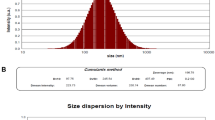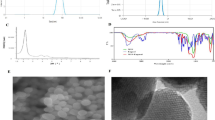Abstract
Colorectal cancer ranks third in terms of diagnosis and second concerning cancer-related mortality. The current research is aimed to synthesize cisplatin-loaded mesoporous silica nanoparticles modified with NH2 and zinc (Zn-MSN-NH2-CP) through a sol–gel process and test their cytotoxicity against colon cancer cells in vitro. HT-29 and HUVEC cell lines were grown in supplemented DMEM medium. MTT test was used to determine the cytotoxicity of prepared formulations against normal cells as well as cancer cells. Real-time PCR was utilized to assess the expression of the apoptotic genes in HT-29 treated with CP, Zn-MSN-NH2, and Zn-MSN-NH2-CP. Necrosis or early and late apoptosis were also evaluated in cancerous cells through the flow method. Physicochemical characteristics of Zn-MSN-NH2 were assessed by SEM, TEM, DLS, and FT-IR techniques. According to the release profile, surface modification of Zn-MSN-NH2-CP resulted in a more regulated CP release. The Zn-MSN-NH2-CP was more stable at 4 °C. Cancerous cells were significantly affected by the cytotoxic effects of both CP and Zn-MSN-NH2-CP. Zn-MSN-NH2 could also minimize the toxicity of the unbound drug towards normal cells, while considerably increasing its viability. Compared to the controls, the expression of pro-apoptotic genes was enhanced in cells treated with IC50 concentrations of Zn-MSN-NH2-CP and CP, while the expression of BCL-2 mRNA showed a decline. Flow cytometry findings also revealed a substantial increase in the early and late apoptosis in cells treated with Zn-MSN-NH2-CP. These in-vitro findings introduce Zn-MSN-NH2 as a promising nanocarrier for increasing the bioavailability and anti-cancer efficacy of CP in colon cancer cells.
Graphical Abstract











Similar content being viewed by others
Notes
Colorectal cancer.
Mesoporous silica nanoparticles.
Cisplatin.
3-Aminopropyl.
Dynamic light scattering.
Transmission electron microscope.
Scanning electron microscope.
Fourier-transform infrared spectroscopy.
Fetal bovine serum.
Analysis of variance.
References
Douaiher J et al (2017) Colorectal cancer—global burden, trends, and geographical variations. J Surg Oncol 115(5):619–630. https://doi.org/10.1002/jso.24578
Siegel RL et al (2020) Colorectal cancer statistics,2020. CA: Cancer J Clin 70(3):145–164. https://doi.org/10.3322/caac.21601
Sawicki T et al (2021) A review of colorectal cancer in terms of epidemiology, risk factors, development, symptoms and diagnosis. Cancers 13(9):2025. https://doi.org/10.3390/cancers13092025
Sargent D et al (2009) Evidence for cure by adjuvant therapy in colon cancer: observations based on individual patient data from 20,898 patients on 18 randomized trials. J Clin Oncol 27(6):872. https://doi.org/10.1200/JCO.2008.19.5362
Shah MA et al (2016) Impact of patient factors on recurrence risk and time dependency of oxaliplatin benefit in patients with colon cancer: analysis from modern-era adjuvant studies in the adjuvant colon cancer end points (ACCENT) database. J Clin Oncol 34(8):843. https://doi.org/10.1200/JCO.2015.63.0558
Lee CS, Ryan EJ, Doherty GA (2014) Gastro-intestinal toxicity of chemotherapeutics in colorectal cancer: the role of inflammation. World J Gastroenterol: WJG 20(14):3751. https://doi.org/10.3748/wjg.v20.i14.3751
Jurj A et al (2017) The new era of nanotechnology, an alternative to change cancer treatment. Drug Des Dev Ther 11:2871. https://doi.org/10.2147/DDDT.S142337
Tang F, Li L, Chen D (2012) Mesoporous silica nanoparticles: synthesis, biocompatibility and drug delivery. Adv Mater 24(12):1504–1534. https://doi.org/10.1002/adma.201104763
Vivero-Escoto JL et al (2010) Mesoporous silica nanoparticles for intracellular controlled drug delivery. Small 6(18):1952–1967. https://doi.org/10.1002/smll.200901789
Rajani C et al (2020) Cancer-targeted chemotherapy: emerging role of the folate anchored dendrimer as drug delivery nanocarrier. Pharmaceutical applications of dendrimers. Elsevier, London, pp 151–198. https://doi.org/10.3390/molecules25173982
Tamanoi F (2018) Mesoporous slica-based nanomaterials and biomedical applications-part A. Academic Press
Ali I et al (2013) Platinum compounds: a hope for future cancer chemotherapy. Anticancer Agents Med Chem 13(2):296–306. https://doi.org/10.2174/1871520611313020016
Sastry J, Kellie SJ (2005) Severe neurotoxicity, ototoxicity and nephrotoxicity following high-dose cisplatin and amifostine. Pediatr Hematol Oncol 22(5):441–445. https://doi.org/10.1080/08880010590964381
Duan X et al (2016) Nanoparticle formulations of cisplatin for cancer therapy. Wiley Interdisc Rev: Nanomed Nanobiotechnol 8(5):776–791. https://doi.org/10.1002/wnan.1390
Vivero-Escoto JL, Elnagheeb M (2015) Mesoporous silica nanoparticles loaded with cisplatin and phthalocyanine for combination chemotherapy and photodynamic therapy in vitro. Nanomaterials 5(4):2302–2316. https://doi.org/10.3390/nano5042302
Varache M et al (2019) Loading of cisplatin into mesoporous silica nanoparticles: Effect of surface functionalization. Langmuir 35(27):8984–8995. https://doi.org/10.1021/acs.langmuir.9b00954
Vallet-Regí M et al (2017) Mesoporous silica nanoparticles for drug delivery: Current insights. Molecules 23(1):47. https://doi.org/10.3390/molecules23010047
Moodley T, Singh M (2019) Polymeric mesoporous silica nanoparticles for enhanced delivery of 5-fluorouracil in vitro. Pharmaceutics 11(6):288. https://doi.org/10.3390/pharmaceutics11060288
Alipoor FJ, Asadi MH, Torkzadeh-Mahani M (2018) MIAT lncRNA is overexpressed in breast cancer and its inhibition triggers senescence and G1 arrest in MCF7 cell line. J Cell Biochem 119(8):6470–6481. https://doi.org/10.1002/jcb.26678
Vickers NJ (2017) Animal communication: when I’m calling you, will you answer too? Curr Biol 27(14):R713–R715. https://doi.org/10.1016/j.cub.2017.05.064
Martínez-Carmona M, Colilla M, Vallet-Regí M (2015) Smart mesoporous nanomaterials for antitumor therapy. Nanomaterials 5(4):1906–1937. https://doi.org/10.3390/nano5041906
Castillo RR, Colilla M, Vallet-Regí M (2017) Advances in mesoporous silica-based nanocarriers for co-delivery and combination therapy against cancer. Expert Opin Drug Deliv 14(2):229–243. https://doi.org/10.1080/17425247.2016.1211637
Vallet-Regí M, Colilla M, González B (2011) Medical applications of organic–inorganic hybrid materials within the field of silica-based bioceramics. Chem Soc Rev 40(2):596–607. https://doi.org/10.1039/C0CS00025F
Lu J et al (2010) Biocompatibility, biodistribution, and drug-delivery efficiency of mesoporous silica nanoparticles for cancer therapy in animals. Small 6(16):1794–1805. https://doi.org/10.1002/smll.201000538
Tao Z et al (2008) Mesoporous silica nanoparticles inhibit cellular respiration. Nano Lett 8(5):1517–1526. https://doi.org/10.1021/nl080250u
Raval N et al (2019) Importance of physicochemical characterization of nanoparticles in pharmaceutical product development. Basic fundamentals of drug delivery. Elsevier, pp 369–400. https://doi.org/10.1016/B978-0-12-817909-3.00010-8
Liu W et al (2018) Galactosylated chitosan-functionalized mesoporous silica nanoparticles for efficient colon cancer cell-targeted drug delivery. Royal Soc Open Sci 5(12):181027. https://doi.org/10.1098/rsos.181027
Dasari S, Tchounwou PB (2014) Cisplatin in cancer therapy: molecular mechanisms of action. Eur J Pharmacol 740:364–378. https://doi.org/10.1016/j.ejphar.2014.07.025
Gao Y et al (2011) Controlled intracellular release of doxorubicin in multidrug-resistant cancer cells by tuning the shell-pore sizes of mesoporous silica nanoparticles. ACS Nano 5(12):9788–9798. https://doi.org/10.1021/nn2033105
Lu J et al (2007) Mesoporous silica nanoparticles as a delivery system for hydrophobic anticancer drugs. Small 3(8):1341–1346
Khosravian P et al (2016) Mesoporous silica nanoparticles functionalized with folic acid/methionine for active targeted delivery of docetaxel. Onco Targets Ther 9:7315. https://doi.org/10.2147/OTT.S113815
Campbell KJ, Tait SW (2018) Targeting BCL-2 regulated apoptosis in cancer. Open Biol 8(5):180002. https://doi.org/10.1098/rsob.180002
Brentnall M et al (2013) Caspase-9, caspase-3 and caspase-7 have distinct roles during intrinsic apoptosis. BMC Cell Biol 14(1):1–9. https://doi.org/10.1186/1471-2121-14-32
Uhlmann S et al (2012) Global microRNA level regulation of EGFR-driven cell-cycle protein network in breast cancer. Mol Syst Biol 8(1):570. https://doi.org/10.1038/msb.2011.100
Decock J et al (2011) Matrix metalloproteinases: protective roles in cancer. J Cell Mol Med 15(6):1254–1265. https://doi.org/10.1111/j.1582-4934.2011.01302.x
Sharifi S, Dalir Abdolahinia E, Ghavimi MA, Dizaj SM, Aschner M, Saso L, Khan H (2022) Effect of Curcumin-Loaded Mesoporous Silica Nanoparticles on the Head and Neck Cancer Cell Line, HN5. Curr Issues Mol Biol 44(11):5247-5259. https://doi.org/10.3390/cimb44110357
Krętowski R et al (2017) The effects of silica nanoparticles on apoptosis and autophagy of glioblastoma cell lines. Nanomaterials 7(8):230. https://doi.org/10.3390/nano7080230
Sancho-Martínez SM et al (2011) Necrotic concentrations of cisplatin activate the apoptotic machinery but inhibit effector caspases and interfere with the execution of apoptosis. Toxicol Sci 122(1):73–85. https://doi.org/10.1093/toxsci/kfr098
Zhou Y et al (2018) Mesoporous silica nanoparticles for drug and gene delivery. Acta pharmaceutica sinica B 8(2):165–177. https://doi.org/10.1016/j.apsb.2018.01.007
Mishra S et al (2020) Folic acid-conjugated magnetic mesoporous silica nanoparticles loaded with quercetin: a theranostic approach for cancer management. RSC Adv 10(39):23148–23164. https://doi.org/10.1039/D0RA00664E
Acknowledgements
The statements made herein are solely the responsibility of the authors. The author, Hirad Sinafar would like to acknowledge Research Assistant of Islamic Azad University Parand Branch due to the support granted through the Graduate Research Assistantship Program.
Author information
Authors and Affiliations
Corresponding author
Ethics declarations
Declarations
As Corresponding Author, I confirm that the manuscript has been read and approved for submission by all the named authors.
Conflict of interest
The authors declare no competing interests.
Additional information
Publisher's note
Springer Nature remains neutral with regard to jurisdictional claims in published maps and institutional affiliations.
We declare that this manuscript is original, has not been published before, and is not currently being considered for publication elsewhere.
.
Rights and permissions
Springer Nature or its licensor (e.g. a society or other partner) holds exclusive rights to this article under a publishing agreement with the author(s) or other rightsholder(s); author self-archiving of the accepted manuscript version of this article is solely governed by the terms of such publishing agreement and applicable law.
About this article
Cite this article
Sinafar, H., Noorbazargan, H., Tafvizi, F. et al. Evaluation of apoptotic and anti-metastatic effects by modified mesoporous silica nanoparticles (MSNs) with Zn and NH2 containing cisplatin on HT-29 cell line. J Nanopart Res 25, 89 (2023). https://doi.org/10.1007/s11051-023-05729-y
Received:
Accepted:
Published:
DOI: https://doi.org/10.1007/s11051-023-05729-y




